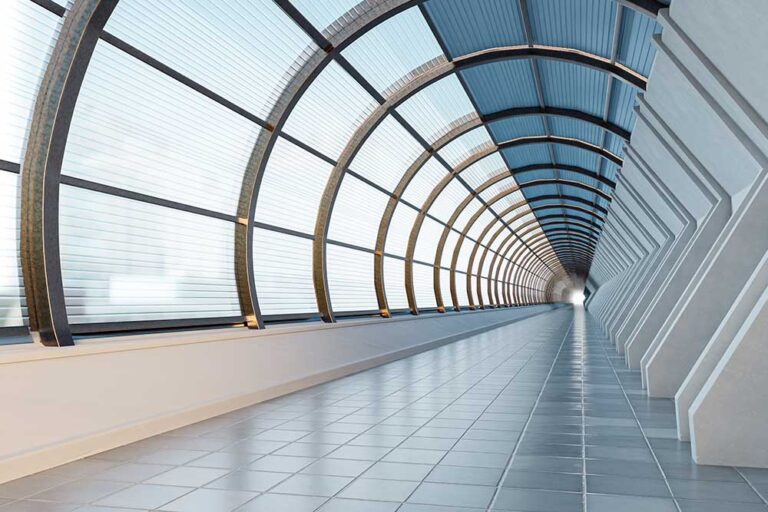Step into a world where design transcends the limits of conventional materials.
Explore the possibilities of architecture and interior design with the power of Bent Glass. With its ability to be shaped and molded into complex and innovative forms, Bent Glass is revolutionizing the way we envision and create spaces. By bending the rules of traditional design, architects and designers are embracing the unique qualities of Bent Glass to push the boundaries of what is possible. From curved glass facades that create stunning visual impact to graceful arches and spirals that transform interiors, the versatility of Bent Glass allows for endless creative expression. Not only does Bent Glass offer aesthetic appeal, but it also provides functional benefits. Its strength and safety properties make it an ideal choice for applications such as staircases, balustrades, and glass floors. Additionally, its ability to enhance natural light flow and create a sense of openness adds a new dimension to living and working spaces. Join us as we delve into the world of Bent Glass and discover how this innovative material is reshaping the future of design and architecture. Get ready to unleash the power of Bent Glass and revolutionize your space.
Advantages of Using Bent Glass in Design and Architecture
Bent glass presents a myriad of advantages for designers and architects alike. Its seamless curves and smooth edges add a touch of sophistication to any space, while its versatility allows for creative freedom in design. Moreover, bent glass offers enhanced durability and strength compared to traditional flat glass, making it suitable for various architectural applications. From creating visually stunning facades to sleek interior elements, the possibilities with bent glass are endless.
Types of Bent Glass
1. Annealed Glass
Annealed glass is the most basic form of glass, often referred to as “standard” or “float” glass. It is produced by slowly cooling molten glass to relieve internal stresses, resulting in a product with uniform thickness and relatively low strength. Annealed glass is highly versatile and easy to fabricate, making it suitable for a wide range of applications. In the context of bent glass, practitioners can heat annealed glass to its softening point and then carefully bend or shape it into desired curves. They commonly utilize it in curved windows, decorative elements, and architectural features where a smooth, uniform appearance is desired. However, it’s important to note that annealed glass is more prone to breakage and thermal stress compared to tempered or laminated glass.
2. Tempered Glass
Tempered glass, also known as toughened glass, is processed through a special heat treatment called tempering. During tempering, the glass is heated to a high temperature and then rapidly cooled, inducing compressive stress on the surface while the interior remains in tension. This process enhances the strength and durability of the glass, making it approximately four to five times stronger than annealed glass of the same thickness. In the case of bent glass, tempered glass can be heated to its softening point and then bent into shape using specialized equipment. Due to its increased strength and safety features, tempered bent glass is commonly used in applications requiring resistance to impact and thermal stress, such as staircases, balustrades, exterior facades, and automotive windows.
3. Laminated Glass
In the context of bent glass, practitioners can bend or curve laminated glass after completing the lamination process. Laminated glass is composed of two or more layers of glass bonded together with an interlayer of polyvinyl butyral (PVB) or ethylene-vinyl acetate (EVA) resin. They fuse the layers together under heat and pressure, resulting in a single, solid piece of glass with enhanced structural integrity and safety properties. The interlayer provides additional strength and safety, preventing the glass from shattering upon impact. Laminated bent glass is often used in applications where safety and security are paramount, such as building facades, skylights, canopies, and overhead glazing. Additionally, laminated glass offers superior sound insulation properties, making it suitable for noise-sensitive environments such as airports, museums, and residential buildings located in urban areas.
Each type of bent glass offers unique properties and advantages, allowing designers and architects to select the most appropriate option based on the specific requirements of their project. Whether it’s the versatility of annealed glass, the strength of tempered glass, or the safety features of laminated glass, bent glass provides endless possibilities for creative expression in design and architecture.
Techniques for Bending Glass
1. Hot Bending
In hot bending, practitioners shape glass by heating it to a high temperature until it becomes pliable. They heat the glass in a furnace or kiln to its softening point, typically around 600 to 700 degrees Celsius (1112 to 1292 degrees Fahrenheit), depending on the type of glass being used. Once the glass reaches this temperature, they manipulate it into the desired shape using molds, rollers, or other forming tools. Hot bending allows for intricate designs and precise curves, making it ideal for creating custom-shaped glass elements with smooth edges and seamless transitions. This technique is commonly used in architectural applications such as curved windows, skylights, glass canopies, and decorative features where aesthetic appeal and design flexibility are paramount.
2. Cold Bending
Cold bending, also known as mechanical bending or gravity bending, involves shaping glass at room temperature without the need for heating. Specialized machinery is used to apply controlled pressure to the glass, bending it into the desired form gradually. Unlike hot bending, which relies on the glass becoming pliable through heat, cold bending relies on the elasticity of the glass to achieve the desired curvature. This technique offers greater control over the final shape and allows for the creation of complex curves and geometries. Architects commonly use cold bending in architectural applications requiring tight tolerances and precise curvature, such as curved glass facades, curved glass partitions, and curved glass railings.
3. Chemical Tempering
In chemical tempering, practitioners utilize controlled chemical processes to increase the strength and flexibility of glass by immersing it in a chemical bath containing a potassium salt solution, such as potassium nitrate or potassium chloride. The chemical ions in the solution replace the sodium ions on the surface of the glass, creating a compressive stress layer that strengthens the glass and increases its resistance to impact and thermal stress. To promote diffusion of the potassium ions into the glass surface, practitioners heat the glass to a high temperature, followed by rapid cooling to lock in the compressive stress. Chemical tempering enhances the structural integrity and safety of the glass, making it ideal for applications requiring high strength and durability, such as automotive windshields, glass doors, and architectural glass panels.
Each bending technique offers unique advantages and applications, allowing designers and architects to achieve their desired aesthetic and functional requirements. Whether it’s the versatility of hot bending, the precision of cold bending, or the strength of chemical tempering, glass bending techniques play a crucial role in pushing the boundaries of design and innovation in architecture and construction.
Applications of Bent Glass in Architecture
Certainly! Let’s delve deeper into the applications of bent glass in architecture:
1. Facades
Bent glass is increasingly being used in architectural facades to create visually striking and dynamic designs. Curved glass panels can add a sense of movement and fluidity to building exteriors, breaking away from the traditional straight lines and angular shapes. By incorporating curved glass elements into facades, architects can achieve innovative and eye-catching architectural expressions that stand out in urban landscapes. Whether used as a feature element or as part of a larger facade system, bent glass offers endless possibilities for creating unique and memorable building exteriors.
2. Windows
Curved windows are another popular application of bent glass in architecture, offering both aesthetic and functional benefits. From panoramic bay windows to gracefully arched openings, curved glass windows can transform interior spaces by providing expansive views, abundant natural light, and a sense of openness. By maximizing daylight penetration, curved windows help reduce the need for artificial lighting, resulting in energy savings and improved occupant comfort. Additionally, curved windows can enhance the architectural character of a building, adding visual interest and enhancing its overall appeal.
3. Partitions
Bent glass partitions are a versatile solution for dividing interior spaces while maintaining a sense of openness and transparency. Whether used in commercial offices, hospitality settings, or residential interiors, curved glass partitions can create visual interest and define separate areas without sacrificing natural light or spatial flow. By incorporating curved glass partitions, architects can introduce a sense of elegance and sophistication to interior spaces, allowing for seamless integration with surrounding architectural elements. Moreover, curved glass partitions can enhance the perceived spaciousness of a room, making it feel larger and more inviting.
4. Stairs
Bent glass staircases are a contemporary and stylish addition to modern architectural designs. By replacing traditional railing systems with curved glass panels, architects can create visually stunning staircases that appear to float effortlessly in space. Curved glass staircases offer a sense of transparency and lightness, allowing for unobstructed views and sightlines throughout the interior. Additionally, the smooth, curved surfaces of glass staircases add a touch of elegance and sophistication to any space, making them ideal for high-end residential projects, commercial buildings, and public spaces.
Innovative Designs Using Bent Glass in Interiors
1. Glass Tables
Bent glass tables with curved edges are a popular choice in modern interior design. These tables exude sophistication and elegance, serving as focal points in living rooms, dining areas, and reception spaces. The seamless curves of bent glass tables create a sense of fluidity and lightness, enhancing the overall aesthetic of the room. Additionally, the transparency of glass allows for unobstructed views, making smaller spaces appear larger and more open. Designers can play with different shapes, sizes, and thicknesses of glass to create custom tables that fit the unique style and function of each space.
2. Floating Glass Shelves
Floating glass shelves add a touch of elegance and sophistication to bathrooms, kitchens, and other living spaces. Unlike traditional shelving systems, which rely on brackets or supports for stability, floating glass shelves appear to “float” on the wall, creating a sleek and minimalist look. Custom-designed bent glass shelves can fit specific dimensions and contours, allowing seamless integration into any interior design scheme.. These shelves provide a functional yet stylish storage solution for displaying decorative objects, books, or everyday essentials while maximizing visual space and light.
3. Bent Glass Countertops
Bent glass countertops offer a modern and luxurious alternative to traditional countertop materials such as granite or marble. The smooth, curved surfaces of bent glass countertops create a sleek and minimalist aesthetic, adding a touch of sophistication to both residential and commercial interiors. In addition to their visual appeal, bent glass countertops are highly durable, scratch-resistant, and easy to clean, making them ideal for kitchens, bars, and reception areas. With advancements in glass fabrication techniques, designers can customize bent glasses countertops to suit the unique requirements and design preferences of their clients.
Innovative fabrication techniques, such as hot bending and cold bending, allow designers to push the boundaries of creativity and explore new dimensions in glass design. Whether it’s creating custom-shaped tables, floating shelves, or curved countertops, bent glasses offers endless possibilities for creating sleek, stylish, and functional furnishings that enhance the aesthetic appeal of any interior space. By incorporating bent glasses elements into their designs, designers can elevate the overall look and feel of interiors, creating spaces that are both visually stunning and highly functional.
Challenges and Considerations When Working with Bent Glasses
1. Complex Bending Process
- The process of bending glass is intricate and requires specialized equipment and expertise.
- Achieving precise curves and shapes demands careful planning and execution throughout the bending process.
2. Risk of Optical Distortion
- Bending glass can lead to optical distortion, affecting the clarity and visual quality of the glass.
- Controlling and minimizing optical distortion is crucial for maintaining the aesthetic integrity of bent glasses installations.
3. Surface Imperfections
- During the bending process, surface imperfections such as ripples, waves, or scratches may occur.
- Addressing surface imperfections through proper handling and finishing techniques is essential to ensure the quality of the final product.
4. Glass Thickness
- The thickness of the glass can influence its ability to bend and withstand stress.
- Selecting the appropriate glass thickness for a given application is critical to ensure structural integrity and safety.
5. Curvature Radius
- The curvature radius determines the degree of bending achievable with the glass.
- Designers must consider the desired curvature radius when specifying bent glasses, as it impacts both the aesthetics and structural performance of the final product.
6. Edge Treatments
- Proper edge treatments are necessary to maintain the safety and durability of bent glasses installations.
- Beveled, polished, or rounded edges can enhance the visual appeal and reduce the risk of injury from sharp edges.
7. Collaboration with Experienced Professionals
- Working with experienced glass manufacturers and fabricators is crucial for ensuring the successful integration of bent glasses into architectural projects.
- Collaborating with professionals who have expertise in glass bending techniques can help mitigate challenges and ensure the desired outcomes are achieved.
Addressing these challenges and considerations proactively is essential for achieving high-quality bent glasses installations that meet both aesthetic and functional requirements. By understanding the complexities involved in working with bent glasses and leveraging the expertise of experienced professionals, designers and architects can unlock the full potential of this versatile material in their projects.
Finding a Reliable Bent Glasses Supplier or Manufacturer
When sourcing bent glasses for architectural projects, it’s essential to partner with a reputable supplier or manufacturer. Glass World a leading provider of high-quality bent glasses solutions, offers a wide range of products and services tailored to meet the unique needs of designers and architects. With a commitment to innovation, craftsmanship, and customer satisfaction, Glass World sets the standard for excellence in the glass industry. By choosing Glass World as your trusted partner, you can rest assured that your bent glasses requirements will be met with precision and professionalism.
Future Trends in Bent Glasses Design and Architecture
In conclusion, bent glasses continues to redefine the boundaries of design and architecture, offering unparalleled beauty, versatility, and durability. As advancements in technology and manufacturing techniques continue to evolve, we can expect to see even more innovative applications of bent glasses in the years to come. From curved skyscraper facades to futuristic interior installations, the future of bent glasses design is indeed promising. By embracing this versatile material and pushing the limits of creativity, designers and architects can create truly iconic spaces that inspire and delight for generations to come.
For personalized glass solutions that exceed expectations, Glass World can be your trusted partner. Get in touch with us today to explore our extensive range and find the ideal glass products for your projects.


